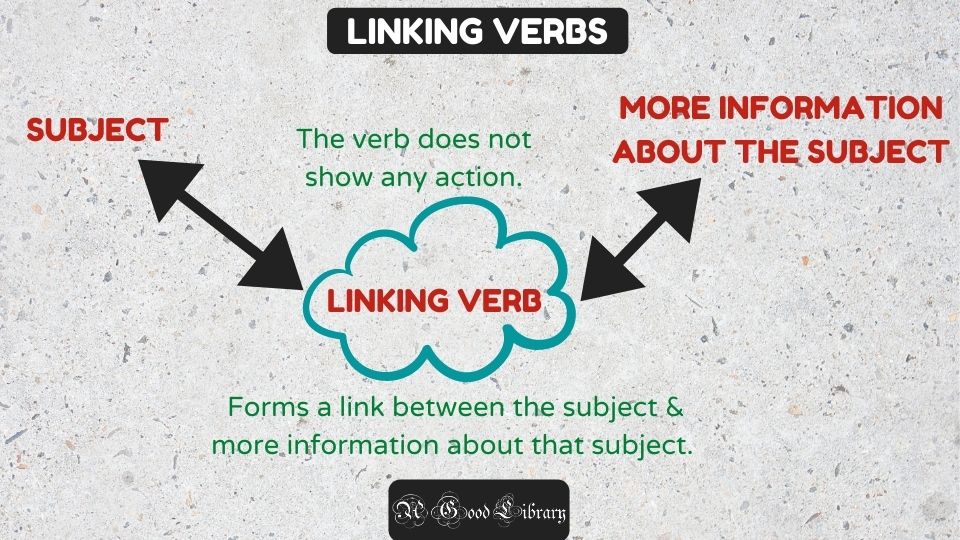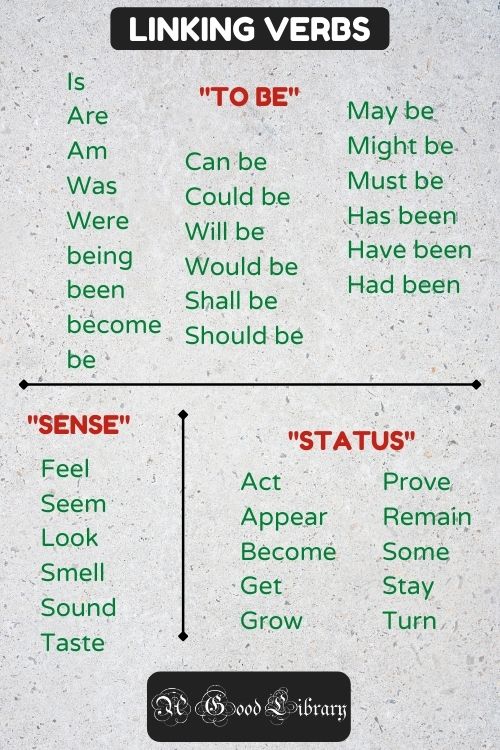You’ll come across this term, Linking Verbs, a lot of times in your study of English Grammar. It looks difficult but it is a very simple concept. In this article, we will look at what are Linking verbs & how they work in a simple way!
Linking verb in a sentence creates a link between the Subject & more information about that subject (usually renames the subject). This rename can be an adjective, noun, or pronoun). Unlike the action verbs (to run, to swim, etc.), Linking verbs do not depict an action. Rather, linking verbs tend to perceive the environment & try to depict the state of the subject. Examples, to feel, to sound, to be, to become, etc.
| CONTENTS: What are Linking Verbs? What are Non-linking Verbs? What’s their relation with Linking Verbs? – What’s the Difference Between Linking Verbs & Helping Verbs (Auxiliary Verbs)? – Can Linking Verbs have Helping Verbs? – Can Linking Verbs be Action Verbs? List of Linking Verbs Examples of Sentences with Linking Verbs Can we use Adverbs with Linking Verbs? Are Linking Verbs Transitive or Intransitive? Takeaway |
What are Linking Verbs?


As we saw in the definition, the Linking verb in a sentence creates a link between the Subject & more information about that subject (usually renames the subject). This rename can be an adjective, noun, or pronoun).
The Noun, Noun Phrase, Adjective, Adjective Phrase, or Pronoun that renames the subject or provides more information about the subject is known as SUBJECT COMPLEMENT.
Let’s break this definition down with an example.
“Sheldon looks like a praying mantis.”
What/Who is the subject here? – Sheldon
What more information is given about the subject? or What name has replaced the original subject? – mantis
Since the adjective ‘praying’ is attached to ‘mantis’, let’s upgrade our answer to the last question:
What more information is given about the subject? or What name has replaced the original subject? – praying mantis
Which verb is helping this replacement? – to look like (the form used in this sentence: looks like – 3rd person singular)
Isn’t it straightforward now? The sentence is renaming ‘Sheldon’ as ‘a praying mantis’ by mentioning his quality of “looking like” a praying mantis.
As we saw in the definition, the Linking verb in a sentence creates a link between the Subject & more information about that subject (usually renames the subject). This rename can be an adjective, noun, or pronoun).
The Noun, Noun Phrase, Adjective, Adjective Phrase, or Pronoun that renames the subject or provides more information about the subject is known as SUBJECT COMPLEMENT.
Let’s break this definition down with an example.
“Sheldon looks like a praying mantis.”
What/Who is the subject here? – Sheldon
What more information is given about the subject? or What name has replaced the original subject? – mantis
Since the adjective ‘praying’ is attached to ‘mantis’, let’s upgrade our answer to the last question:
What more information is given about the subject? or What name has replaced the original subject? – praying mantis
Which verb is helping this replacement? – to look like (the form used in this sentence: looks like – 3rd person singular)
Isn’t it straightforward now? The sentence is renaming ‘Sheldon’ as ‘a praying mantis’ by mentioning his quality of “looking like” a praying mantis.
What are Non-linking Verbs? What’s their relation with Linking Verbs?
All those verbs which are not ‘Linking Verbs’ are ‘Non-Linking Verbs’. Simple. So, all Action verbs (to climb, to raise, to fall, to dance, etc.) and Helping Verbs are Non-linking.
What’s the Difference Between Linking Verbs & Helping Verbs (Auxiliary Verbs)?
A linking verb forms a direct link between the subject and the Noun/Pronoun/Adjective that renames the subject or provides more information about the subject. While a helping verb is used before an action or linking verbs (main verb of the sentence). Helping verbs provide more information about the probability of the action/event/status or the time.
Helping verbs can never be the main verb of the sentence. But, Linking verbs can be the main verb of the sentence.
This brings us to the next question –
Can Linking Verbs have Helping Verbs?
Yes. Definitely. Linking Verbs can have Helping Verbs. Helping verb usually appears before the Linking verb in a sentence.
Consider an example:
“You’re being very rude!”
Here, ‘are’ is playing the role of helping verb to the main verb ‘being’.
Can Linking Verbs be Action Verbs?
Linking Verbs cannot be Action Verbs. Action Verbs depict the presence of an action or a movement. While Linking Verbs do not depict an action or a movement. Instead, Linking Verbs indicate the presence of a sense or the steady state of being.
List of Linking Verbs:

Examples of Sentences with Linking Verbs
Here are some sentences that will help you concretize your understanding of Linking Verbs:
| Sr. | Sentence |
|---|---|
| 1 | She is always happy to be at her uncle’s farmhouse. |
| 2 | Don’t talk to your friends like that. You’re being very rude! |
| 3 | All the kittens at my place are cute and cuddly. |
| 4 | Don’t eat the apples! They are smelling a little rotten. |
| 5 | Add some cinnamon to the dessert. It will taste really nice. |
| 6 | Clearing the final exam is proving to be very hard for him. |
| 7 | Alice is not happy. |
| 8 | He appears to be not happy. |
Can we use Adverbs with Linking Verbs?
Adverbs can be used with Linking Verbs in a sentence. But, Adverbs can never be used in the place of the subject complement.
For example,
“Alice appeared to be sick.”
You can use the adverb ‘Suddenly’ with the verb ‘appear’ but not as a replacement to ‘sick’.
“Alice suddenly appeared to be sick.” – Makes sense.
“Alice appeared to be suddenly.” – Doesn’t make sense.
Another example where subject complement is a noun phrase.
“That tiny dot turned out to be an old bohemian house.”
Here, the subject is ‘That tiny dot’ while the subject complement is ‘old bohemian house’. Let’s try adding an adverb.
“That tiny dot surprisingly turned out to be an old bohemian house.” – Makes sense.
Are Linking Verbs Transitive or Intransitive?
A typical transitive verb provides a link between the subject and the object in the sentence. A typical intransitive verb does not provide such a link.
Simply saying – A transitive verb needs an object while an intransitive verb does not need an object.
For example,
“The cat eats a rat.”
In this sentence, ‘The cat’ is the subject of the verb ‘eats’ & ‘a rat’ is the object of the verb ‘eats’. Here, ‘Eats’ is a transitive verb as it has an object – ‘a rat’.
“The cat is eating.”
In this sentence, ‘The cat’ is the subject of the main verb ‘eating’. ‘Is’ is a helping verb. But there is no object. Yet, the sentence is still both grammatically correct & making sense. Here, ‘Eating’ is an intransitive verb.
Having understood this pretext, let’s answer the question at hand – Are Linking Verbs Transitive or Intransitive?
Linking Verbs are Intransitive.
REASONS: Linking verbs connect the subject with this complement (predicates). Predicates are not objects. Also, Linking verbs do not depict the presence of action; they just depict a presence of sense or the state of being. Transitive verbs need the subject to act on the object. So, that makes Linking Verbs Intransitive.
Conclusion
Linking Verb forms a category of Verbs that function in a particular way. These linking verbs help us form a connection between the subject and its complement – anything that provides more information about the main subject or renames it. It can be an adjective, an adjective phrase, a noun, a noun phrase, or a pronoun.
Hope you enjoyed reading this article!

